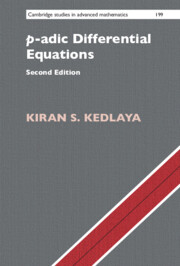Book contents
- Frontmatter
- Contents
- Preface
- Acknowledgments
- 0 Introductory remarks
- Part I Tools of p-adic Analysis
- Part II Differential Algebra
- Part III p-adic Differential Equations on Discs and Annuli
- 8 Rings of functions on discs and annuli
- 9 Radius and generic radius of convergence
- 10 Frobenius pullback and pushforward
- 11 Variation of generic and subsidiary radii
- 12 Decomposition by subsidiary radii
- 13 p-adic exponents
- Part IV Difference Algebra and Frobenius Modules
- Part V Frobenius Structures
- Part VI The p-adic local monodromy theorem
- Part VII Global theory
- Appendix A Picard–Fuchs modules
- Appendix B Rigid cohomology
- Appendix C p-adic Hodge theory
- References
- Index of notation
- Subject index
10 - Frobenius pullback and pushforward
from Part III - p-adic Differential Equations on Discs and Annuli
Published online by Cambridge University Press: 06 August 2022
- Frontmatter
- Contents
- Preface
- Acknowledgments
- 0 Introductory remarks
- Part I Tools of p-adic Analysis
- Part II Differential Algebra
- Part III p-adic Differential Equations on Discs and Annuli
- 8 Rings of functions on discs and annuli
- 9 Radius and generic radius of convergence
- 10 Frobenius pullback and pushforward
- 11 Variation of generic and subsidiary radii
- 12 Decomposition by subsidiary radii
- 13 p-adic exponents
- Part IV Difference Algebra and Frobenius Modules
- Part V Frobenius Structures
- Part VI The p-adic local monodromy theorem
- Part VII Global theory
- Appendix A Picard–Fuchs modules
- Appendix B Rigid cohomology
- Appendix C p-adic Hodge theory
- References
- Index of notation
- Subject index
Summary
In this chapter, we introduce Dwork’s technique of descent along Frobenius in order to analyze the generic radius of convergence and subsidiary radii of a differential module, primarily in the range where Newton polygons do not apply. In one direction, we introduce a somewhat refined form of the Frobenius antecedents introduced by Christol and Dwork. These fail to apply in an important boundary case; we remedy this by introducing the new notion of Frobenius descendants. Using these results, we are able to improve a number of results from Chapter 6 in the special case of differential modules over ??_??. For instance, we get a full decomposition by spectral radius, extending the visible decomposition theorem and the refined visible decomposition theorem. We will use these results again to study variation of subsidiary radii, and decomposition by subsidiary radii, in the remainder of Part III.
Information
- Type
- Chapter
- Information
- p-adic Differential Equations , pp. 179 - 195Publisher: Cambridge University PressPrint publication year: 2022
